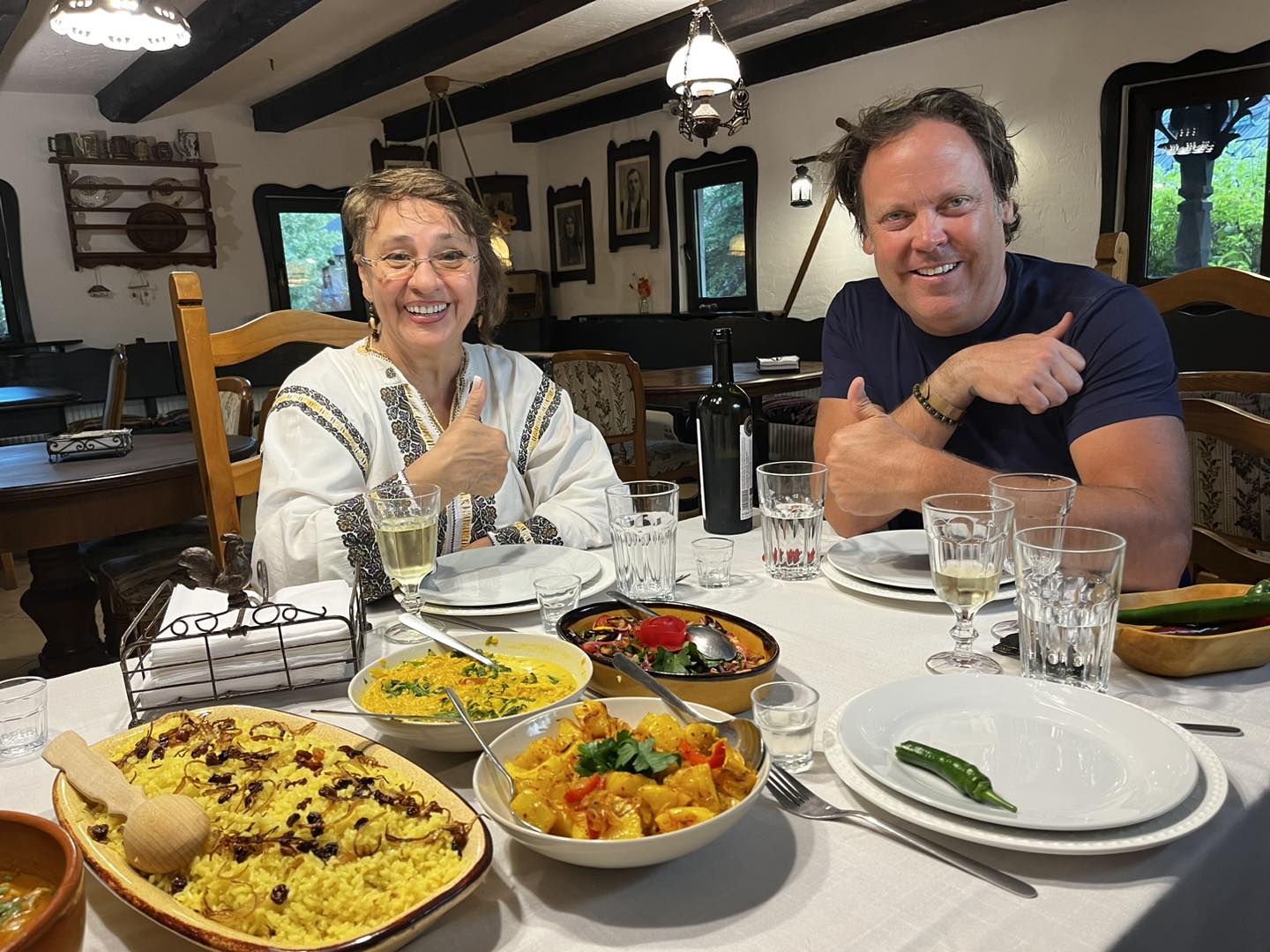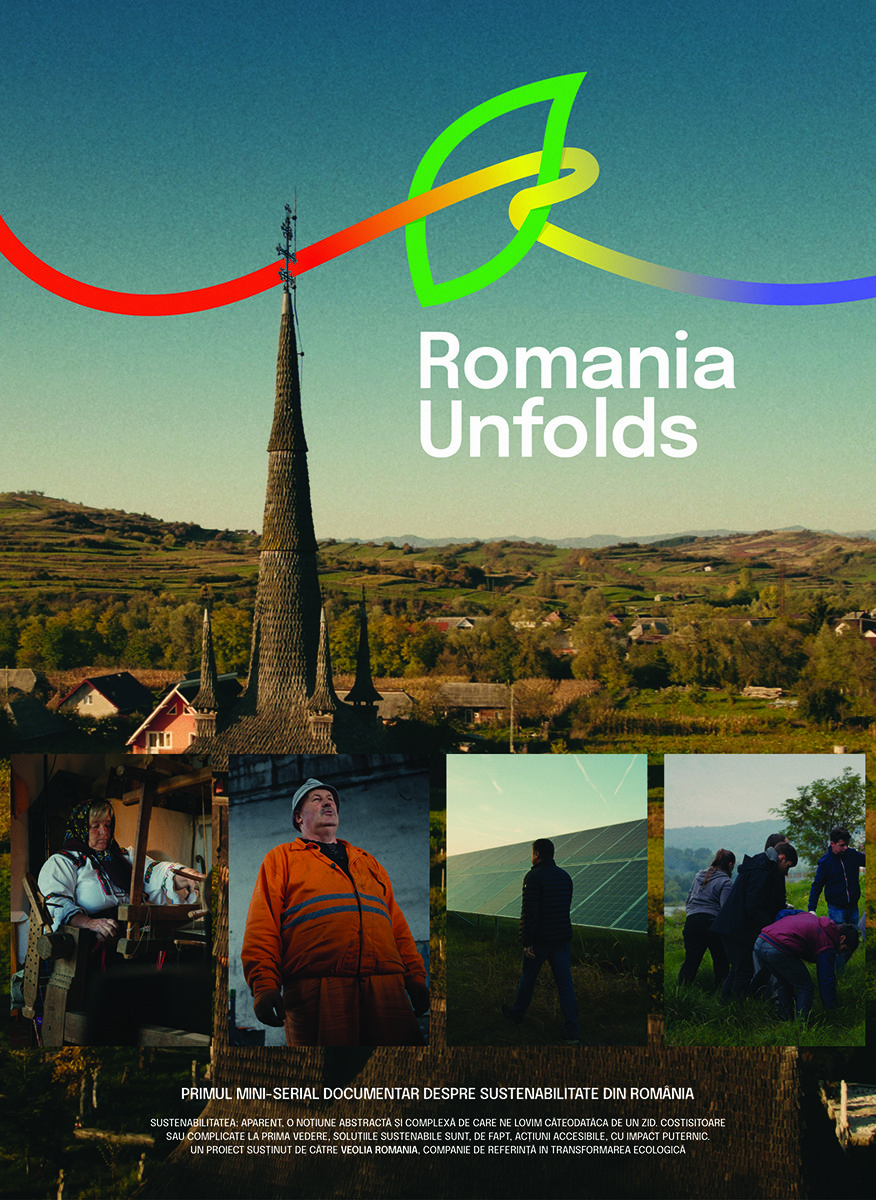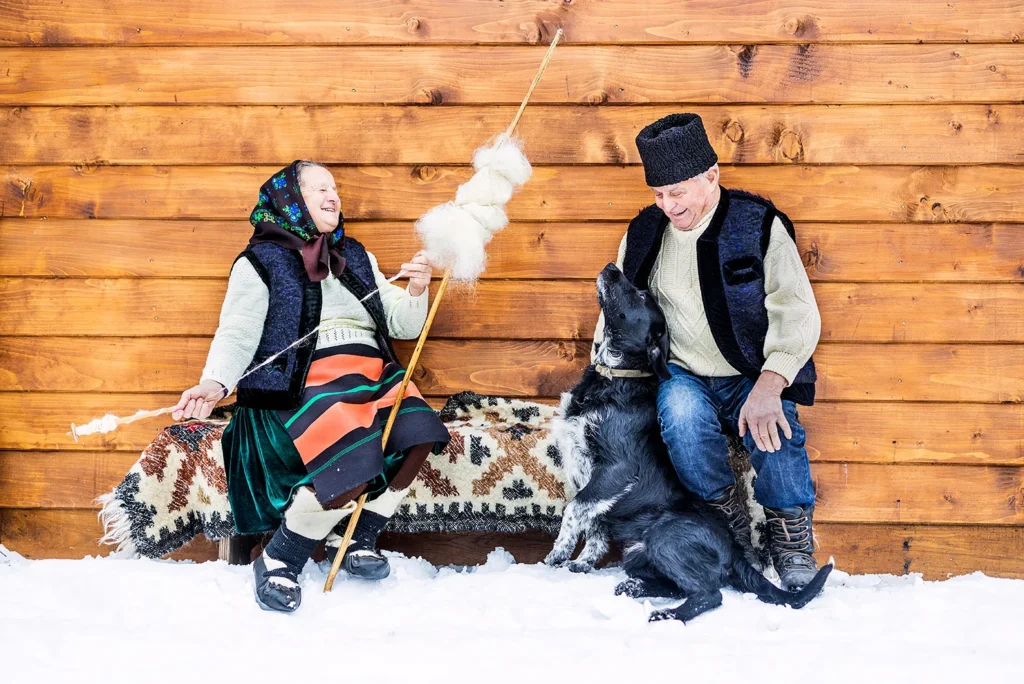Chapters
Romania is not an easy country to explain in a few words. It’s layered, contradictory, and often misunderstood from the outside. For many people abroad, the first real contact with the country doesn’t come from travel brochures or news articles, but from film.
In recent years, documentaries about Romania have become one of the most honest ways to understand the country. They take time to show how people live, how food is made, how nature still survives, and how traditions adapt to modern life. Some focus on wilderness, others on culture or sustainability, but all of them slow things down and let Romania speak for itself.
This article looks at several documentaries about Romania that helped shape how the country is seen internationally — not by promoting it, but by observing it.
Flavors of Romania
(2019–2023)
Seasons
- Season 1: 2019
- Season 2: 2021
- Season 3: 2023
- Multi-season documentary series, each season focusing on different regions, traditions, and culinary narratives across Romania
IMDb rating
- IMDb rating: 9.1 / 10
- One of the highest-rated documentaries about Romania, with strong engagement from international viewers interested in food, culture, and slow travel
Producers & key staff
- Creator & Host: Charlie Ottley
- Production: Asphalt Tango Productions
- Director: Charlie Ottley
- Cinematography: Charlie Ottley & team
- Music: Original score inspired by regional Romanian folklore
The series builds on the same production philosophy established by Ottley in Wild Carpathia, combining cinematic visuals with immersive, narrative-driven storytelling.
Description
Flavors of Romania is a culinary and cultural journey that uses food as a gateway into Romania’s layered history, landscapes, and identity. Rather than presenting recipes in a conventional cooking-show format, the series places local producers, families, artisans, and traditions at the heart of each episode.
From village kitchens to mountain pastures, vineyards, and riverbanks, food becomes a way to talk about memory, survival, and belonging. Dishes are rarely separated from the land that produces them, or from the people who keep these traditions alive.
Charlie Ottley’s approach is deliberately unhurried, allowing stories to unfold organically and giving space to silence, landscape, and human connection.
Destinations featured
Across its three seasons, the series covers a broad geographical and cultural spectrum, including:
- Transylvania – Saxon villages, fortified churches, seasonal cuisine
- Maramureș – wood-fired cooking, preserved traditions, family rituals
- Bucovina & Moldova – monastic food culture, rural self-sufficiency
- The Danube Delta – fishing communities and water-based gastronomy
- Dobrogea – multicultural influences and Black Sea flavors
- Wallachia & Oltenia – pastoral cuisine and historic trade routes
The destinations are never isolated from their context; each region is presented as a living ecosystem of people, food, and history.

Photo source: facebook.com/flavoursofromania.official
Why the documentary matters
- Redefines culinary storytelling: food is treated as cultural heritage, not entertainment
- Preserves intangible heritage: many practices shown are disappearing or rarely documented on film
- Accessible entry point to Romanian culture: ideal for audiences unfamiliar with the country
- Balances beauty with realism: avoids romantic clichés while remaining visually rich
For many international viewers, Flavors of Romania becomes their first meaningful encounter with the country.
Critical reception & industry recognition
International media
- The Guardian described the series as:
“A sensuous, respectful exploration of a food culture shaped by history, hardship, and extraordinary landscapes.”
- The Telegraph praised its depth, noting:
“More than a food series, it is a meditation on place, tradition, and what Europe has forgotten.”
Industry and cultural commentary
- Food and travel critics have consistently highlighted the series for avoiding exoticism, instead allowing Romanian voices to lead the narrative
- The show is frequently cited in discussions about slow food, sustainability, and rural resilience, particularly in Eastern Europe
Audience response
- Viewers often describe Flavors of Romania as “intimate,” “unexpectedly moving,” and “a reminder that food is identity”—sentiments reflected in its exceptional IMDb score
This culinary journey documentary is available for streaming on Netflix in many regions — a great place to watch it if you have a subscription.
Where to watch
This culinary journey documentary is available for streaming on Netflix in many regions — a great place to watch it if you have a subscription.
Netflix: https://www.netflix.com/ro-en/title/81285938
Wild Carpathia
(2011-2016)
IMDb rating
- 9.1
Seasons
- 4 episodes
Each episode functions like a standalone film, forming one of the most influential environmental documentaries about Romania ever produced.
Producers & Key Staff
- Presented by: Charlie Ottley
- Produced by: Off the Fence Productions (BAFTA- and Emmy-award-winning company)
- Executive Producer: Ellen Windemuth
- Partnerships: UNESCO, The Prince’s Trust
- Narration contributions: HRH King Charles III (then Prince Charles) in key segments
- Distribution: Travel Channel, international broadcasters, festivals
General Description
Wild Carpathia is a landmark series — not just in Romania, but globally — because it introduced the world to the mystical, untouched wilderness of the Carpathian Mountains.
The documentary blends:
- extraordinary cinematography,
- ecological storytelling,
- ancient traditions,
- and heartfelt advocacy for conservation.
Presented by Charlie Ottley, the series explores Romania’s primeval forests, wildlife corridors, remote mountain villages, traditional shepherding routes, and communities living in harmony with nature. Its tone is poetic, at times melancholic, highlighting both the beauty and the environmental threats facing Romania’s last wild frontiers.
The presence of HRH King Charles — a passionate supporter of Romanian heritage — further elevated the film’s profile, making Wild Carpathia an international reference point for conversations about biodiversity and cultural preservation.

Photo source: youtube.com
Why the Documentary Matters
- It became one of the most influential environmental documentaries about Romania, sparking international awareness and conservation efforts.
- It highlights landscapes that many Europeans didn’t even know still existed — forests older than nations, valleys untouched by modern development.
- It portrays traditional pastoral life as an endangered treasure, not a nostalgic postcard.
- It inspired countless travelers to discover Transylvania, Bucovina, and the Southern Carpathians in respectful, sustainable ways.
Destinations Featured
The Carpathian Mountains
- Făgăraș Mountains
- Piatra Craiului National Park
- Retezat National Park
- Bucegi Mountains
- Apuseni Mountains
The series showcases vast virgin forests, glacial lakes, alpine ridges, and some of Europe’s last large carnivore populations.
Transylvania’s Rural Heartlands
- Zărnești
- Măgura & Peștera villages
- Viscri, Biertan & other Saxon heritage villages
- Traditional sheepfolds and shepherding routes
Bucovina & Maramureș
- Wooden churches
- Artisan communities
- Hay meadows and traditional farming landscapes
Danube Delta (briefly)
- Migratory birds
- Fishing communities
- Environmental challenges affecting the region
Critical reception & industry recognition
“A visually stunning tribute to Europe’s last great wilderness.”
— The Guardian (Travel)
“Wild Carpathia set a new global standard for environmental documentaries about Romania.”
— European Nature Film Review
“A poetic call to protect landscapes that feel almost mythological.”
— National Geographic (critic commentary)
“The film’s message resonates far beyond Romania — it speaks to the future of conservation in Europe.”
— Wildlife & Ecology Journal
“Charlie Ottley and his team captured something the world did not know Romania still held: true wilderness.”
— Film & Travel Writers Guild
Where to watch
You can find Wild Carpathia on YouTube, where episodes or clips from the travel documentary series are uploaded publicly. These are often subtitled and freely accessible.
YouTube: https://www.youtube.com/playlist?list=PLeCPQtbuJaPtpfHyG4S-E-gZMWVw9UmHF
Discover Romania with Peter Hurley
(2016)
Seasons
- Single documentary film
- Runtime: approx. 106 minutes
- Although often shared online in three parts, these function as narrative chapters of the same film
Producers & key staff
- Production: AGERPRES (Romania’s National News Agency – AGERPRES Video)
- Director: Camelia Moise
- Producer: Camelia Moise
- Cinematography: Sergiu Olteanu
- Editing: Ioana Matei
The project sits at the intersection of documentary filmmaking and cultural journalism, benefiting from AGERPRES’ long tradition of visual storytelling and archival rigor.
Description
Discover Romania with Peter Hurley follows Irish journalist and writer Peter Hurley, who set out to walk across Romania—literally on foot—from Săpânța (Maramureș) to Bucharest.
The film is structured as a slow, human-scale journey, built around encounters with locals who offer food, shelter, conversation, and insight. Rather than explaining Romania through facts or voice-over exposition, the documentary allows the country to reveal itself organically, through people and places experienced at walking pace.
Hurley’s role is not that of a classic TV presenter. Having lived in Romania for years, he moves through the landscape as both an outsider and an adopted insider—curious, respectful, and visibly changed by the road.
Destinations featured
- Săpânța (Maramureș) – the symbolic starting point, rooted in tradition and strong local identity
- Rural villages across northern and central Romania – visited organically during the walk
- Bucharest – the journey’s endpoint, concluding at the Romanian Peasant Museum, a powerful counterpoint between rural heritage and urban modernity
Rather than ticking off landmarks, the route emphasizes continuity: how villages, landscapes, and people connect across regions.

Photo source: youtube.com
Why the documentary matters
- An antidote to fast travel storytelling: by choosing walking as the core narrative device, the film restores time, silence, and attention to the travel documentary format
- A credible foreign perspective: Hurley’s long-term relationship with Romania avoids superficial fascination and replaces it with empathy and genuine curiosity
- A portrait of everyday Romania: hospitality, resilience, humor, and simplicity emerge naturally—without staging or romantic exaggeration
- Cultural storytelling over promotion: the film doesn’t try to “sell” Romania, which paradoxically makes it more persuasive and memorable
For international audiences, this approach offers an entry point into Romania that feels earned rather than packaged.
Critical reception & industry recognition
- The documentary was selected and screened at CRONOGRAF – International Documentary Film Festival, where it was included in the CadRO section dedicated to Romanian documentary productions
- It was also presented internationally, including at the Romanian Film Festival in China (2016), as part of Romania’s official cultural diplomacy program
While Discover Romania with Peter Hurley hasn’t generated a body of published criticism in major media outlets, audience response and cultural coverage highlight its appeal. Promotional materials emphasize the film as “not just a journey, not just an adventure,” underscoring its reflective tone. Viewers, including Hurley himself, have described Romania as a “real-life fairytale,” capturing the documentary’s core spirit. At international screenings — such as the Romanian Film Festival in Shanghai — commentators noted growing global interest in Romanian cinema and cultural storytelling, underscoring the documentary’s role in expanding Romania’s cultural footprint abroad.
Where to watch
This documentary about walking across Romania is available in full (or in chapters) on YouTube, making it easy to watch online.
YouTube: https://www.youtube.com/watch?v=ywDHSpVui8o&t=2s
România Sălbatică
(Wild Romania, 2021)
Seasons
- Single feature-length documentary
- Runtime: approx. 124 minutes
- Released theatrically and through festivals, later made available on international streaming and educational platforms
IMDb rating
- IMDb rating: 9.1
Producers & key staff
- Directors: Dan Dinu, Cosmin Dumitru
- Producers: NTD Film, Chainsaw Film Productions
- Executive Producer: Dan Dinu
- Cinematography: Dan Dinu, Cosmin Dumitru
- Narration (international version): Victor Rebengiuc (RO), English narration used for global distribution
The film was produced over several years, involving extensive fieldwork, remote filming, and wildlife tracking across multiple seasons.
Description
Recorded over 10 years, Wild Romania is a visually immersive wildlife documentary that explores Romania as one of Europe’s last great natural strongholds. The film reveals a country where ancient forests, untouched wetlands, and wild mountain landscapes still coexist with traditional rural life.
Rather than isolating nature from people, the documentary emphasizes balance: shepherds, villagers, forests, rivers, and wildlife are shown as part of the same living ecosystem. Large carnivores—brown bears, wolves, and lynx—share the screen with birds, insects, and lesser-known species, creating a layered portrait of biodiversity rarely seen in Europe.
The pacing and cinematography place Wild Romania closer to high-end international nature productions than to classical national documentaries.
Destinations featured
- The Carpathian Mountains – alpine meadows, old-growth forests, large carnivore habitats
- Apuseni Mountains – karst landscapes and traditional mountain villages
- Danube Delta – wetlands, birdlife, and aquatic ecosystems
- Transylvania – forested hills, pastures, and human–nature interaction
- Ancient virgin forests across multiple regions
The locations are not presented as tourist stops, but as ecological systems in motion.

Photo source: imbdb.com
Why the documentary matters
- Positions Romania as a major European wilderness: the film challenges the perception that true wilderness exists only outside Europe
- Raises environmental awareness: it addresses deforestation, habitat fragmentation, and human responsibility without becoming overtly didactic
- International production quality: visually and narratively comparable to BBC Earth or National Geographic productions
- Reframes Romania’s image abroad: shifting focus from stereotypes to biodiversity, conservation, and ecological value
For international audiences, Wild Romania often comes as a surprise—revealing a side of Europe that feels both ancient and fragile.
Critical reception & industry recognition
International press
- The Guardian praised the film’s visual ambition, noting:
“A reminder that Europe still has places where nature rules — and Romania is at the heart of it.”
- Modern Times Review described it as:
“A visually impressive and emotionally restrained documentary that lets nature speak for itself.”
Festival and industry response
- Screened at major international documentary and environmental film festivals, where it was frequently highlighted for its cinematography and conservation message
- Environmental organizations and educators have cited the film as a powerful advocacy tool for protecting Europe’s last virgin forests
Director’s perspective (from press interviews)
- Director Dan Dinu summarized the intent clearly:
“Romania still has something that most of Europe has lost. The question is how long we can keep it.”
Where to watch
Wild Romania can be watched on HBO Max in certain regions, as well as on Prime Video platform.
You can find the trailer on YouTube: https://www.youtube.com/watch?v=iRBN5Q8NLRY
România neîmblânzită
(Untamed Romania, 2018)
Seasons
- Single feature-length documentary
- Runtime: approx. 90 minutes
IMDb rating
- IMDb rating: 8.8 / 10
- Consistently praised by both Romanian and international audiences, particularly for its cinematography and soundtrack
Producers & key staff
- Director: Dan Dinu
- Producers: NTD Film, Chainsaw Film Productions
- Executive Producer: Dan Dinu
- Cinematography: Dan Dinu, Cosmin Dumitru, Andrei Glăvan
- Music: Original soundtrack by Irina Rimes (a rare and notable choice for a nature documentary)
- Narration: Victor Rebengiuc (Romanian version)
The film was produced over several years and required extensive fieldwork, often in remote and difficult-to-access locations.
Description
România neîmblânzită is a cinematic exploration of Romania’s natural landscapes, presenting the country as one of the last truly wild territories in Europe. The documentary moves fluidly from mountain forests and alpine meadows to wetlands, rivers, and plains, revealing ecosystems that have survived largely intact into the modern age.
What distinguishes the film is its balance between scale and intimacy. Spectacular aerials and wildlife sequences are interwoven with quiet moments that emphasize rhythm, patience, and observation. Humans are mostly absent from the frame, reinforcing the idea of nature as an autonomous force rather than a backdrop.
The result is not a didactic environmental film, but a contemplative one—inviting the viewer to look, listen, and reflect.
Destinations featured
- The Carpathian Mountains – old-growth forests, large carnivores, alpine ecosystems
- Apuseni Mountains – karst landscapes and forest biodiversity
- The Danube Delta – wetlands, birdlife, seasonal transformations
- Southern plains and river systems – illustrating ecological diversity beyond mountains
The film’s geography is deliberately expansive, emphasizing Romania’s role as a continental biodiversity corridor.

Photo source: clujlife.com
Why the documentary matters
- Positions Romania as a European biodiversity stronghold: few countries still host such a concentration of intact ecosystems
- Raises environmental awareness through emotion, not rhetoric: the film avoids overt messaging, allowing imagery and sound to carry meaning
- Bridges cinema and conservation: its theatrical release brought nature documentary into mainstream public conversation
- A milestone for Romanian documentary filmmaking: demonstrating that locally produced nature films can reach international technical and artistic standards
For many viewers, România neîmblânzită reframed Romania not as a peripheral destination, but as an ecological core of Europe.
Critical reception & industry recognition
Press and cultural commentary
- Romanian and international critics highlighted the film’s cinematic ambition, often comparing its visual language to high-end international nature productions
- Cultural publications praised the decision to combine modern music with classical narration, describing it as a bold and effective emotional bridge between generations
Industry response
- Widely screened at festivals, cultural events, and special environmental screenings, where it was frequently cited as a reference title for Romanian nature documentaries
- Environmental NGOs and educators embraced the film as a powerful awareness tool, particularly in discussions about deforestation and habitat protection
Critical tone
- While overwhelmingly positive, some commentary noted the film’s aestheticized portrayal of wilderness, a discussion that has only strengthened its relevance in debates about conservation versus idealization
Where to watch
România neîmblânzită (Untamed Romania) is available on Amazon Prime Video and Netflix, in selected regions, depending on local catalog availability.
Watch it on Amazon Prime Video: https://www.primevideo.com/dp/amzn1.dv.gti.9eb6236f-622d-3043-8c81-624deb93e6f3?autoplay=0&ref_=atv_cf_strg_wb
Romania Unfolds
(2023– )
Seasons
- Ongoing documentary series
- Structured as standalone episodes, each exploring a sustainability-related theme or initiative
- Digital-first format, released episodically rather than in classic TV seasons
IMDb rating
- Not listed on IMDb
- As a niche, impact-driven sustainability series, its reach and relevance are better measured through institutional use, partnerships, and audience engagement than through entertainment platforms
Producers & key staff
- Production: Romania Unfolds (independent sustainability storytelling project)
- Format: Documentary series focused on sustainability, regeneration, and responsible development
- Editorial approach: Story-led, without a presenter; emphasis on people, initiatives, and long-term impact rather than narration
The project sits closer to impact media and sustainability communication than to traditional travel or nature documentaries.
Description
Romania Unfolds is a documentary series dedicated to exploring sustainable practices and regenerative initiatives across Romania. Each episode focuses on individuals, communities, or projects that are actively reshaping the relationship between people, land, and resources.
Rather than framing sustainability as an abstract concept, the series grounds it in real-life action: how food is produced, how landscapes are protected, how communities adapt, and how traditions can support — rather than hinder — long-term resilience.
The tone is calm, observational, and solution-oriented, avoiding both alarmism and idealization.
Destinations & themes featured
Instead of classic destinations, the series is organized around themes, including:
- Sustainable agriculture & local food systems
- Regenerative rural communities
- Responsible tourism initiatives
- Craft, circular economy & small-scale production
- Nature conservation linked to livelihoods
Geographically, episodes move through rural Romania, with a strong presence in Transylvania and other regions where sustainability is practiced at community level.

Photo source: digi24.ro
Why the documentary matters
- Shifts the sustainability narrative: from theory to practice, showing what actually works on the ground
- Positions Romania as part of the solution: not as a country “catching up,” but as one with valuable models rooted in tradition
- Highly relevant to modern audiences: especially those interested in conscious travel, ethical consumption, and regenerative living
- Bridges tradition and innovation: sustainability is shown as continuity, not rupture
Within an article on documentaries about Romania, Romania Unfolds adds a contemporary, forward-looking layer that complements nature-focused and cultural titles.
Critical reception & industry recognition
- While not widely reviewed by mainstream film critics, the series is valued within sustainability, tourism, and impact-media circles
- Episodes are frequently used as conversation starters around responsible development and community-led change
- The project aligns with a broader European trend toward purpose-driven documentary storytelling, where impact matters more than ratings
Where to watch
As a more recent impact/documentary series focused on sustainability, this one may be available on the project’s own platforms or YouTube playlists dedicated to documentary content about Romania.
Watch it here: https://www.romaniaunfolds.ro/
Final Thoughts
When you watch these documentaries about Romania together, a clear pattern appears. None of them try to impress. They don’t rush from place to place and they don’t explain everything. They focus on people, landscapes, and real situations.
Each documentary shows a different side of Romania, but together they feel consistent. They show a country that is still deeply connected to nature, food, and community, and one that is slowly changing without losing everything along the way.
For anyone who wants to understand Romania beyond stereotypes, these documentaries are a good place to start. They don’t promise answers — they simply show the country as it is.





